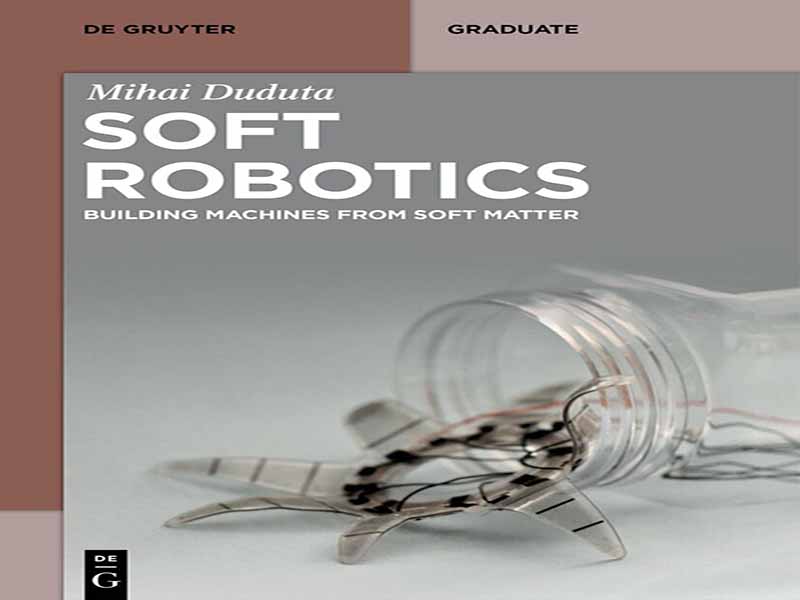- عنوان کتاب: Soft Robotics -Building Machines from Soft Matter
- نویسنده: Mihai Duduta
- حوزه: رباتیک
- سال انتشار: 2025
- تعداد صفحه: 158
- زبان اصلی: انگلیسی
- نوع فایل: pdf
- حجم فایل: 4.84 مگابایت
این کتاب محصول یک ضرورت است: من به عنوان معلم یک دوره آموزشی در زمینه رباتیک نرم، نتوانستهام کتابی پیدا کنم که یک تازهکار در این زمینه را قادر سازد تا به سرعت اصول اولیه را درک کند. هنگام شروع به نوشتن کتاب، به دنبال چارچوبی بودم که به درک بین ایدههای بسیار متنوعی که در حوزه رو به رشد میانرشتهای رباتیک نرم قرار میگیرند، کمک کند. برای کسانی که با این اصطلاحات کمتر آشنا هستند، رباتهای نرم نشاندهنده دستهای از ماشینها هستند که از موادی به نرمی سیستمهای زنده ساخته شدهاند. نتیجه استفاده از این بلوکهای سازنده، قابلیتهای منحصر به فردی است که به رباتهای نرم اجازه میدهد در طیف وسیعی از محیطهای غیرقابل دسترس برای رباتهای سفت و سخت، از جمله محیطهای بدون ساختار (مانند محیطهای بسیار سخت، مناطق فاجعهبار)، در نزدیکی افراد (مانند فضاهای تولید مشترک، همراهان خانگی و رباتیک مراقبتهای بهداشتی) و فراتر از آن، فعالیت کنند. از آنجایی که ماده نرم یک حوزه وسیع، میانرشتهای و رو به رشد است، ماشینهای ساخته شده از این بلوکهای سازنده در نحوه ساخت و عملکرد خود پیچیدهتر میشوند. موضوع مشترک این کتاب انرژی است: چگونه انرژی توسط ماشینهای نرم جمعآوری، ذخیره، تبدیل و تحویل داده میشود تا قابلیتهای رباتیک را فعال کند؟ این کتاب با تمرکز بر انرژی به عنوان یک زبان مشترک در فناوریهای مختلف، خواننده را قادر میسازد تا اصول هر رویکرد را درک کند و قابلیتهای رباتیک را بین آنها مقایسه کند. در نتیجه، این کتابی نیست که به شدت بر طراحی رباتهای نرم متمرکز باشد. برای علاقهمندان به موضوع طراحی، گزینههای فوقالعادهای در دسترس است: یک مثال، کتاب «علم رباتهای نرم» است که توسط کوئیچی سوزوموری، کنجیرو فوکودا، ریوما نیاما و کوهی ناکاجیما ویرایش شده است. مثال دیگر، که بیشتر بر نمونههای «خودت انجام بده» متمرکز است، کتاب «رباتیک نرم: مقدمهای بر رباتهای نرم، کشسان و انعطافپذیر» نوشته متیو بورگاتی و کاری لاو است. علاوه بر این، با توجه به سرعت بالای این حوزه، این کتاب به دنبال ارائه جدیدترین نمونههای تحقیقاتی نیست. در عوض، نمونههای تحقیقاتی نشان داده شده، مفاهیم را به واضحترین و سرراستترین شکل ممکن ارائه میدهند. این کتاب با هدف ارتباط با رباتیک سفت و سخت مرسوم، به دنبال ارائه بلوکهای سازنده حیاتی است: حسگری، محاسبه، ذخیرهسازی انرژی و مکانیسمهای تحریک. با این حال، در زمان نگارش این کتاب، بزرگترین چالش در رباتیک نرم هنوز تحریک است. از آنجایی که رباتهای نرم قصد دارند تواناییهای حرکتی سیستمهای زنده را بازتولید کنند، محققان در این زمینه در تلاشند تا نمونههای مصنوعی از عضلات طبیعی را پیدا کنند. به عنوان یک هدف طراحی، عضلات طبیعی عملکرد فوقالعادهای با انرژی ویژه تا 40 ژول بر کیلوگرم و فرکانس تحریک از 0.1 تا 300 هرتز نشان میدهند. علاوه بر این، عضلات طبیعی سیستمهای چند منظوره هستند که قادر به ایفای نقش به عنوان مولدهای حرارتی (مثلاً لرزیدن)، فنر برای حرکات ضربهای، ذخیرهسازی شیمیایی و حتی دارای حس عمقی یا خودحسی تعبیه شده میباشند. ساختار کتاب به شرح زیر است: فصل اول ماده نرم را معرفی میکند و عمدتاً بر الاستومرها تمرکز دارد. در حالی که فومها، ژلها، کلوئیدها و سایر سیستمهای ماده نرم دارای خواص منحصر به فرد و جالبی هستند، اکثریت قریب به اتفاق کارها در رباتیک نرم با هدف توسعه و پردازش الاستومر برای تولید ساختارهای نرم انجام میشود. فصل دوم، رساناهای الکترونیکی کشسان را شرح میدهد که به عنوان پایهای برای حسگرهای مقاومتی و خازنی تغییر شکلپذیر عمل میکنند، و همچنین بلوکهای سازنده برای محرکهای الکترومکانیکی، ذخیرهسازی انرژی کشسان و سیستمهای برداشت انرژی. چهار فصل بعدی، چهار روش اصلی تحریک را شرح میدهند: سیستمهای سیال، مبدلهای الکترومکانیکی، مواد پاسخگو به حرارت و محرکهای مغناطیسی. برای هر فصل، تمرکز بر چگونگی تبدیل انرژی از یک منبع انرژی خاص به حرکتی است که میتواند برای کار مکانیکی مرتبط با رباتیک استفاده شود. فصل هفتم، مکانیسمهای چسبندگی، به ویژه چسبهای الکتروچسبندگی و الهام گرفته از مارمولک را شرح میدهد که هم برای رباتیک مرتبط هستند و هم برای عملکرد به مواد نرم متکی هستند. فصل آخر، مباحث پیشرفتهتری را خلاصه میکند که سایر بلوکهای سازنده رباتیک را پوشش میدهند، اما به اندازه فصلهای قبلی تثبیت نشدهاند. هر فصل شامل برخی از مباحث اساسی فیزیک، شیمی یا علم مواد است که عملکرد دستگاه را توضیح میدهد. برای فصلهای محرک و چسبندگی، تمرکز بر مکانیسم انتقال انرژی است. مکانیسمهای مختلف به صورت موازی برای درک عمیقتر بررسی میشوند. برای مثال، در سیستمهای ترمومکانیکی، آلیاژهای حافظهدار شکلی، مثال متعارف هستند. این فلزات ذاتاً نرم نیستند، اما میتوانند به صورت ساختارهای تغییر شکلپذیر ساخته شوند که با گرم شدن منقبض میشوند. این مواد با الاستومرهای کریستال مایع مقایسه میشوند که مواد نرمی هستند که هنگام گرم شدن، دچار تغییر ساختار میشوند. در نهایت، مثال سوم از طریق مواد تغییر فاز دهنده تعبیه شده در ماتریسهای نرم شرح داده میشود. این مواد معمولاً شامل یک ترکیب فرار هستند که میتواند در دمای بالا به گاز تبدیل شود و یک ماتریس پایدار که
This book is a product of necessity: as a teacher for a course on Soft Robotics, I have not been able to find a book that enables a novice in the field to quickly grasp the basics. When setting out to write the book, I sought a framework that helps bridge understanding between the highly diverse ideas that fall under the growing interdisciplinary field of Soft Robotics. For those less familiar with the terms, Soft Robots represent a class of machines that are made of materials as soft as living systems. The result of using these building blocks is unique capabilities that allow soft robots to operate in broad range of environments inaccessible to rigid robots, including unstructured environments (e. g., extreme environments, disaster zones), in the proximity of people (e. g., collaborative manufacturing spaces, home companions, and healthcare robotics), and beyond. With Soft Matter being a vast, interdisciplinary, and growing field, the machines made from these building blocks are becoming more complex in how they are made and how they are operated. The common theme for this book is energy: how is energy harvested, stored, transformed, and delivered by soft machines to enable robotic capabilities? By focusing on energy as a common language across different technologies, the book enables the reader to understand the fundamentals of each approach, and to compare robotic capabilities between them. As a result, this is not a book focused heavily on design of soft robots. For those interested in the topic of design, there are fantastic options available: one example is The Science of Soft Robots edited by Koichi Suzumori, Kenjiro Fukuda, Ryuma Niiyama, and Kohei Nakajima. Another example, more focused on Do-It-Yourself examples is Soft Robotics: A DIY Introduction to Squishy, Stretchy, and Flexible Robots by Matthew Borgati and Kari Love. Additionally, given the rapid pace in the field, this book does not seek to capture the latest research examples. Instead, the research examples shown capture the concepts in the clearest and most straightforward way possible. Aiming to relate to conventional rigid robotics, the book seeks to capture the critical building blocks: sensing, computation, energy storage, and actuation mechanisms. However, at the time of writing this book, the greatest challenge in soft robotics is still actuation. As soft robots aim to reproduce locomotion abilities of living systems, researchers in the field aim to find artificial replicas of natural muscles. As a design target, natural muscles show extreme performance with specific energy up to 40 J/kg and actuation frequency ranging from 0.1 to 300 Hz. Moreover, natural muscles are multifunctional systems, capable to serve as thermal generators (i. e., shivering), springs for impulsive movements, chemical storage, and even have embedded proprioception, or self-sensing. The structure of the book is as follows: the first chapter introduces soft matter, focusing primarily on elastomers. While foams, gels, colloids, and other soft matter systems have unique and interesting properties, the vast majority of work in Soft Robotics is aimed at elastomer development and processing to produce soft structures. The second chapter describes stretchable electronic conductors, which serve as the basis for deformable resistive and capacitive sensors, as well as building blocks for electro-mechanical actuators, stretchable energy storage, and harvesting systems. The following four chapters describe the four main actuation modalities: fluid powered systems, electro-mechanical transducers, thermally responsive materials, and magnetic actuators. For each chapter, the focus is on how energy is transduced from a specific energy source into a motion that can be used for robotically-relevant mechanical work. The seventh chapter describes adhesion mechanisms, specifically electro-adhesion and gecko-inspired adhesives, which are both relevant for robotics and rely on soft materials for operation. The final chapter summarizes more advanced topics that cover other robotic building blocks, but they are not as established as the previous chapters. Each chapter includes some fundamental physics, chemistry, or materials science that explains the device operation. For actuator and adhesion chapters, the focus is on the energy transduction mechanism. Different mechanisms are examined in parallel for a deeper understanding. For example, in thermo-mechanical systems the canonical example is shape memory alloys. These metals are not inherently soft, but can be fabricated into deformable structures that contract upon heating. These materials are compared with liquid crystal elastomers, which are soft materials that undergo a structural reorganization when heated. Lastly, a third example is described through phase change materials embedded in soft matrices. These materials typically incorporate a volatile compound that can become a gas at elevated temperature and a stable matrix that prevents the gas from escaping. Although the three systems rely on different phase changes, the fundamental energy transfer mechanism is the same, and the challenges of adding and removing heat rapidly in a robotic component are similar across the systems. Understanding these topics, as well as the overall actuator specific energy and thermo-mechanical energy efficiency, enable a student of Soft Robotics to improve upon the state of the art. For a bit of historical context, soft robotics is not a new field: patents that are nearly a century old describe soft rubber bladders being used as sphygmomanometers or blood pressure monitoring devices. McKibben air muscles, which are a type of soft actuator and will be discussed at length in Chapter 3, were invented in 1957 per the original patent. Additionally, Figure 1 shows an example from a 1969 patent describing a mechanism for retrieving torpedoes which relies on inflating hydraulic chambers (see the multiple valves at 36, 42, and 62). Knowledge of soft materials doing work as autonomous robotic systems has been established for decades. The recent explosion in popularity of Soft Robotics is due to the ease of prototyping, which enabled wide adoption of fabrication techniques and engaged a broad community of researchers, looking at both fundamentals in the materials, fabrication, and integration, as well as applications across the economy from collaborative manufacturing, to wearables, healthcare and beyond. This growing community is whom the book is addressed to. The goal of this book is to give the reader the fundamental understanding and practical tools to compare technologies across scales, operation regimes, and fabrication methods. The secondary goal of this book is to teach soft robotics in an interdisciplinary fashion. Soft Robotics now encompasses multiple engineering and scientific disciplines, and a common denominator is needed to orient a novice and empower them to push the boundaries of the field. I hope the structure of and examples in this book convince others to focus on energy and enable new discoveries and understanding. In terms of logistics, this book is aimed to aid an instructor teaching a typical semester long course. It can also be pared down to just a quarter course running over 10 weeks. The course can operate purely as lecture-based one, making use of videos from the reference papers to give the student a thorough understanding of the material. However, the best way to teach soft robotics is learning by doing, and therefore the book includes example laboratory sessions, most of which can be completed with food grade materials and inexpensive laboratory equipment. Example problems are given for homework or exam purposes and a project component is strongly encouraged anytime this course is taught. The book is primarily intended for early career graduate students, so first- or second-year PhD or master students, although the content is accessible to well-prepared advanced undergraduates.
این کتاب را میتوانید از لینک زیر بصورت رایگان دانلود کنید:




































نظرات کاربران